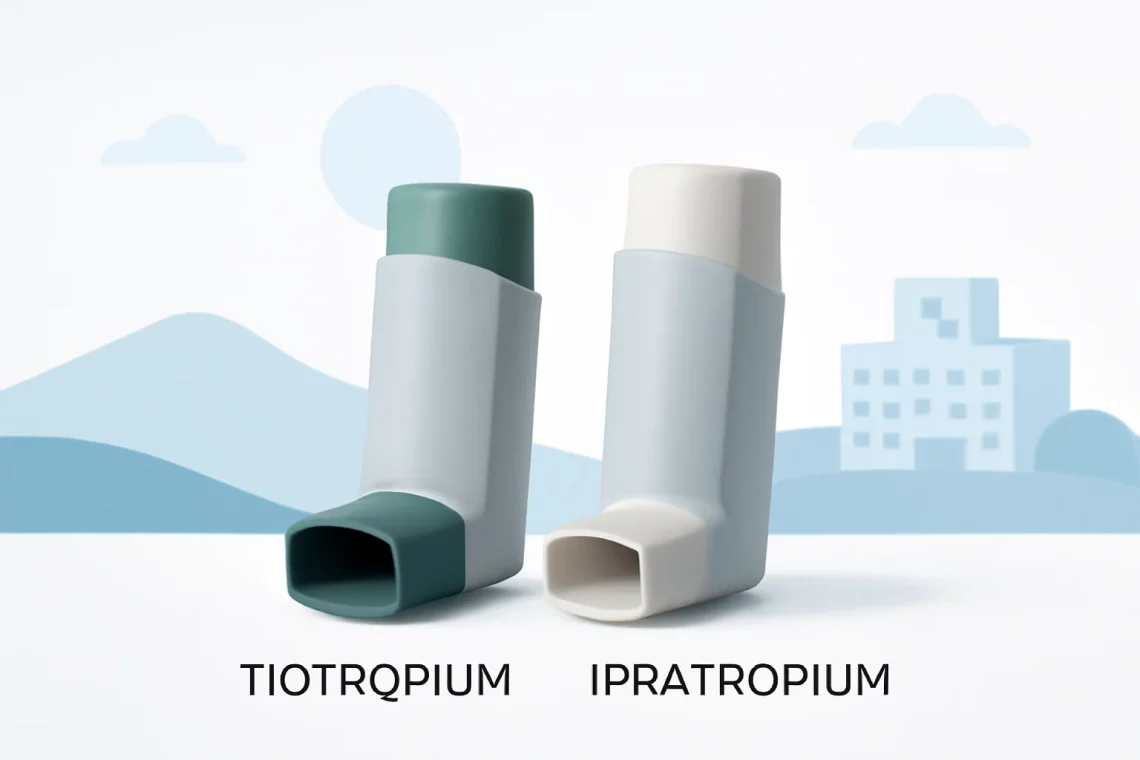
Comparing Tiotropium and Ipratropium: Which is Right for You?
The management of chronic respiratory conditions has evolved significantly over the years, with various medications playing pivotal roles in improving patients’ quality of life. Among these medications are bronchodilators, which are essential in alleviating symptoms associated with conditions like asthma and chronic obstructive pulmonary disease (COPD). Two commonly prescribed medications in this category are Tiotropium and Ipratropium. These drugs, while both classified as anticholinergic bronchodilators, have unique characteristics, mechanisms of action, and clinical applications. Understanding the differences between them is crucial for healthcare providers and patients alike in making informed decisions regarding treatment options. As the demand for effective respiratory therapies continues to rise, the significance of these medications cannot be overstated. Patients often find themselves navigating the complexities of their treatment plans, seeking the best options to manage their symptoms effectively. With respiratory conditions being prevalent, it’s essential to delve into the specifics of Tiotropium and Ipratropium, exploring their uses, benefits, and potential side effects to provide a comprehensive overview for better management of respiratory health.
Mechanism of Action
Tiotropium and Ipratropium work by blocking the action of acetylcholine on muscarinic receptors in the airways, leading to bronchodilation. However, their mechanisms differ in terms of potency, duration of action, and receptor selectivity.
Ipratropium is a short-acting anticholinergic that provides quick relief from acute bronchospasm. By inhibiting the muscarinic receptors, it reduces the bronchial secretions and helps to relax the airway muscles, making it easier for patients to breathe. Typically administered via inhalation, Ipratropium is often used in combination with other bronchodilators, particularly in emergency settings for asthma attacks or exacerbations of COPD. Its onset of action is relatively fast, making it a suitable choice for immediate symptom relief.
On the other hand, Tiotropium is a long-acting anticholinergic that is primarily used for the maintenance treatment of COPD. It has a higher affinity for the muscarinic receptors and a longer duration of action, which allows for once-daily dosing. This extended action is particularly beneficial for patients who require sustained bronchodilation throughout the day. Tiotropium works by providing a more prolonged relaxation of the airway muscles, thus improving lung function over an extended period.
The difference in their mechanisms of action reflects their intended uses. While Ipratropium is effective for quick relief, Tiotropium is designed for long-term management of chronic respiratory conditions. This distinction is essential for clinicians when prescribing these medications, as it allows for tailored treatment plans that align with the patient’s specific needs.
Clinical Applications
The clinical applications of Tiotropium and Ipratropium extend across various respiratory conditions, with each medication serving distinct roles in patient management.
Ipratropium is often utilized in acute care settings, particularly for patients experiencing sudden exacerbations of asthma or COPD. Its rapid onset of action makes it a valuable tool in emergency departments or in the home management of respiratory distress. It is frequently prescribed as part of a combination therapy with short-acting beta-agonists (SABAs) to enhance bronchodilation and improve overall respiratory function. For patients with mild to moderate asthma, Ipratropium can be an effective add-on therapy, especially when traditional bronchodilators are insufficient.
In contrast, Tiotropium is primarily prescribed for the maintenance treatment of COPD. Clinical studies have demonstrated its efficacy in reducing exacerbations, improving lung function, and enhancing health-related quality of life in patients with chronic respiratory diseases. Its once-daily dosing regimen promotes adherence, making it easier for patients to incorporate it into their daily routines. Furthermore, Tiotropium has been shown to have benefits beyond bronchodilation, including potential anti-inflammatory effects, which may contribute to its long-term efficacy in managing COPD.
Both medications have been evaluated in various clinical trials, providing evidence for their safety and efficacy. However, the choice between Tiotropium and Ipratropium ultimately depends on the patient’s specific condition, severity of symptoms, and treatment goals. Healthcare providers must consider these factors when prescribing these medications to ensure optimal management of respiratory conditions.
Side Effects and Considerations
Like all medications, Tiotropium and Ipratropium come with potential side effects that patients should be aware of. Understanding these side effects is crucial for informed decision-making and effective management of respiratory conditions.
Ipratropium, being a short-acting anticholinergic, is generally well-tolerated. However, some common side effects include dry mouth, throat irritation, and dizziness. These effects are typically mild and resolve quickly after discontinuation of the medication. In rare cases, patients may experience paradoxical bronchospasm, which is a sudden worsening of breathing difficulties. This side effect underscores the importance of using the medication as prescribed and monitoring for any unusual reactions.
Tiotropium, although effective for long-term management, is not without its risks. Common side effects include similar anticholinergic effects, such as dry mouth and constipation. Some patients may also experience urinary retention or difficulty urinating, particularly those with pre-existing urinary conditions. Furthermore, there have been concerns regarding the potential for cardiovascular events in some patients, leading to a cautious approach in those with a history of heart disease.
It is essential for healthcare providers to conduct a thorough assessment of the patient’s medical history and current medications before prescribing either Tiotropium or Ipratropium. This assessment helps to identify any contraindications or potential interactions that could increase the risk of adverse effects. Patients should also be encouraged to report any side effects they experience during treatment, allowing for timely adjustments to their medication regimen if necessary.
In summary, while both Tiotropium and Ipratropium are valuable tools in the management of respiratory conditions, understanding their side effects and considerations is vital for safe and effective use.
**Disclaimer**: This article is not intended as medical advice. For any health-related issues or concerns, please consult a qualified healthcare professional.




